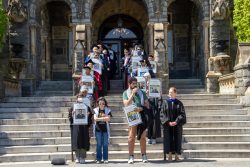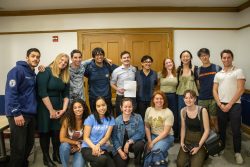On Dec. 1, the Working Group on Slavery, Memory and Reconciliation held a teach-in on “What We Know: Georgetown University and Slavery” in Gaston Hall. The event is part of a series hosted by the group in the wake of last month’s protests to change the names of Mulledy and McSherry Halls, to, temporarily, Freedom and Remembrance Halls, respectively. The halls were previously named after former presidents of the university, Fathers Thomas F. Mulledy, S.J. and William McSherry, S.J. who participated in the sale of the Jesuits’ slaves in 1838.
GUSA Historian Matthew Quallen (SFS ‘16) was the event’s first speaker, outlining a brief summary of the history of the university’s relationship with slavery.
“Georgetown’s relationship to slavery was not simple,” he said. He explained that the Maryland Society of Jesus owned at least 200 slaves in the 18th century, working on plantations that financially supported the then-Georgetown College. The decision to sell 272 slaves to families in Louisiana came in 1838, as the school struggled to pay for new buildings and internal divisions over the role of slavery in the Society were rising.
“[Then-president] McSherry was part of a generation of young American Jesuits who saw the languishing plantations as an unsustainable project,” Quallen said, and who sought to raise funds by arguing for a mass sale.
“In 1838, McSherry and Mulledy received permission from Rome to make the sale,” Quallen said, but only under certain conditions. These requirements are also explained in a pamphlet distributed across campus by the working group, which reads that the Vatican’s decision mandated “that families not be separated, that the money not be used to pay off debt or go to operating expenses, and that provisions be made for the religious practice of slaves.”
“To our knowledge, all of the conditions of the sale were violated,” he said. The sale of these slaves funded paying off the debt of building what would be known as the recently-renamed Mulledy Hall.
Throughout his presentation, Quallen emphasized that Georgetown’s history with slavery was not an isolated phenomenon, and is one that universities across America continue to grapple with. “This does not make Georgetown unique,” he said.
One of these universities that has begun to and continues to address the issues of slavery’s legacy is Brown University in Providence, R.I. Dr. Marcia Chatelain, a professor in Georgetown’s History Department who received her doctorate from Brown in 2008, spoke on the work that the school has undertaken, describing their process as “playing the long game” in reconciling with their history.
“We can assemble committees to do a number of things as an institution, but the response really shows us how far the institution is willing to go,” she said, highlighting the university’s reaction to a comprehensive report released by the Brown University Steering Committee on Slavery and Justice in 2006.
Since then, Brown has installed a memorial to slaves on campus, strengthened its Africana Studies program, established and developed relationships with several historically black colleges and universities, and developed an endowment to support the Providence Public Schools system, in response to historic impacts of slavery on unequal economic development in the city, among other responses, Chatelain said.
However, despite the significant progress made by Brown, she reminded attendees that racial tension and disparities remain on the campus.
“Although we consider it the gold standard of institutions responding to its history, it didn’t solve all the problems,” Chatelain said. She pointed to a recent plan announced by administration on Nov. to spend $100 million over the next decade to address racism, diversity and inclusion.
Chatelain was followed by Dr. Kirt von Daacke, a history professor at the University of Virginia (UVA) and co-chair of the UVA President’s Commission on Slavery and the University who spoke on the process of unearthing and acknowledging the history of slavery on the campus in Charlottesville.
This effort has included installing a memorial to enslaved workers, installing plaques on the sites of previously-unmarked graves of enslaved people, and developing educational resources and classes explaining UVA’s ties to slavery.
He explained the extensive process of student- and alumni-driven actions that led up to the Commission’s creation in 2013, and told the teach-in attendees that “it’s the collaboration of people in this room that will really bring it to fruition.”
The final guest speaker, Professor Charles Villa-Vicencio, spoke about the process of reconciliation and transformation. Villa-Vicencio acted as the national research director of the South African Truth and Reconciliation Committee from 1996 to 1998 and has advised numerous countries recovering from internal strife. Villa-Vicencio began by discussing three aspects of memory: that memory is cross-generational, the sharing of memory is a cathartic process, and those who have suffered the most are cursed with better memory.
Villa-Vicencio emphasized that the goal should not be forgiveness, but rather tolerance. “Forgiveness, a wonderful thing, is not the most practical political option we have. I think it’s reconciliation, a milder form, a more modest form of what we’re asking for in forgiveness. Politically, we don’t have to love one another, we don’t have to embrace one another, we don’t have to forgive one another. We’ve merely got to sit down, stop killing one another, and collectively together forge a new future.”
Villa-Vicencio congratulated the Georgetown community for taking a step where he believed the University of Missouri failed. He mentioned, however, “for the students here, it’s going to take more than your fleeting four years to change this.”
A question and answer session followed, during which suggestions were floated about possible choices for the new building names. Although these ideas included naming the buildings after Jesuits who worked with the poor or after a notable African American, Father David J. Collins, S.J., history professor and chair of the working group, specified that the new names would need to be related to 19th century Georgetown history.
The teach-in concluded with remarks by Collins about the future of the working group. The group is soliciting suggestions for the new names through their webpage. The working group will divide into subgroups to investigate different themes, such as archiving or memorialization. The group will determine if the unmarked cemeteries of slaves exist on campus and how to memorialize them if they do.
Collins also unveiled a new grant program called the Freedom and Remembrance grants to encourage grassroots efforts at engaging with these themes. He similarly announced a Emancipation Day symposium on Apr 18, and a renaming ceremony for the halls on Dec 11.






[…] We Know: Georgetown University and Slavery” booklets across campus prior to a December 2015 teach-in that delved into the university’s “distressing […]
[…] We Know: Georgetown University and Slavery” booklets across campus prior to a December 2015 teach-in that delved into the university’s “distressing […]
[…] Know: Georgetown University and Slavery” booklets across campus prior to a December 2015 teach-in that delved into the university’s “distressing […]